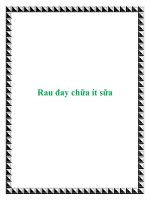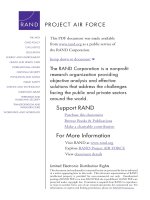What it Takes pot
Bạn đang xem bản rút gọn của tài liệu. Xem và tải ngay bản đầy đủ của tài liệu tại đây (745.06 KB, 142 trang )
This document and trademark(s) contained herein are protected by law as indicated
in a notice appearing later in this work. This electronic representation of RAND
intellectual property is provided for non-commercial use only. Unauthorized
posting of RAND PDFs to a non-RAND Web site is prohibited. RAND PDFs are
protected under copyright law. Permission is required from RAND to reproduce,
or reuse in another form, any of our research documents for commercial use. For
information on reprint and linking permissions, please see RAND Permissions.
Limited Electronic Distribution Rights
Visit RAND at www.rand.org
Explore RAND Project AIR FORCE
View document details
For More Information
This PDF document was made available
from www.rand.org as a public service of
the RAND Corporation.
6
Jump down to document
THE ARTS
CHILD POLICY
CIVIL JUSTICE
EDUCATION
ENERGY AND ENVIRONMENT
HEALTH AND HEALTH CARE
INTERNATIONAL AFFAIRS
NATIONAL SECURITY
POPULATION AND AGING
PUBLIC SAFETY
SCIENCE AND TECHNOLOGY
SUBSTANCE ABUSE
TERRORISM AND
HOMELAND SECURITY
TRANSPORTATION AND
INFRASTRUCTURE
WORKFORCE AND WORKPLACE
The RAND Corporation is a nonprofit
research organization providing
objective analysis and effective
solutions that address the challenges
facing the public and private sectors
around the world.
Purchase this document
Browse Books & Publications
Make a charitable contribution
Support RAND
This product is part of the RAND Corporation monograph series.
RAND monographs present major research findings that address the
challenges facing the public and private sectors. All RAND mono-
graphs undergo rigorous peer review to ensure high standards for
research quality and objectivity.
PROJECT AIR FORCE
Prepared for the United States Air Force
Approved for public release; distribution unlimited
What It
Takes
Air Force Command of Joint Operations
Michael Spirtas
Thomas-Durell Young
S. Rebecca Zimmerman
The RAND Corporation is a nonprofit research organization providing
objective analysis and effective solutions that address the challenges
facing the public and private sectors around the world. RAND’s
publications do not necessarily reflect the opinions of its research clients
and sponsors.
R
®
is a registered trademark.
© Copyright 2009 RAND Corporation
All rights reserved. No part of this book may be reproduced in any
form by any electronic or mechanical means (including photocopying,
recording, or information storage and retrieval) without permission in
writing from RAND.
Published 2009 by the RAND Corporation
1776 Main Street, P.O. Box 2138, Santa Monica, CA 90407-2138
1200 South Hayes Street, Arlington, VA 22202-5050
4570 Fifth Avenue, Suite 600, Pittsburgh, PA 15213-2665
RAND URL:
To order RAND documents or to obtain additional information, contact
Distribution Services: Telephone: (310) 451-7002;
Fax: (310) 451-6915; Email:
Cover design by Peter Soriano.
The research described in this report was sponsored by the United States
Air Force under Contract FA7014-06-C-0001. Further information may
be obtained from the Strategic Planning Division, Directorate of Plans,
Hq USAF.
Library of Congress Cataloging-in-Publication Data
Spirtas, Michael.
What it takes : Air Force command of joint operations / Michael Spirtas,
Thomas-Durell Young, S. Rebecca Zimmerman.
p. cm.
Includes bibliographical references.
ISBN 978-0-8330-4614-7 (pbk. : alk. paper)
1. Unified operations (Military science) 2. United States. Air Force. 3. Command
of troops. I. Young, Thomas-Durell. II. Zimmerman, S. Rebecca. III. Title.
U260.S667 2009
355.3'30410973—dc22
2009001048
iii
Preface
When appropriate, the U.S. Air Force needs to be prepared to supply
joint task force (JTF) headquarters. is monograph seeks to help
Air Force personnel understand the requirements
1
of an effective JTF
headquarters and to identify the broad outlines for how the Air Force
can build and maintain this capability. It considers the nature of JTF
command, surveys command-related developments in other services
and in other elements of the defense community, and examines four
JTF operations. It raises issues for the Air Force to consider and offers
a set of recommendations aimed at enhancing the Air Force’s ability to
staff and run JTF headquarters.
e research documented here should be of interest to a wide
group of Air Force personnel involved in the development and func-
tion of the service’s command organizations, including component–
Numbered Air Force (C-NAF) staff, those working on command
policy, and more generally those interested in the role of air power in
joint operations. It should also be of interest to other members of the
defense community seeking to understand issues related to command
and to the future of joint military operations.
e research reported here was sponsored by the Deputy Chief
of Staff for Operations, Plans and Requirements, Headquarters, U.S.
Air Force. e research was conducted within the Strategy and Doc-
trine Program of RAND Project AIR FORCE for a fiscal year 2007
1
By the term “requirements” we do not mean to imply that we have derived formal Depart-
ment of Defense requirements for JTF command. We use the term to refer to the necessary
characteristics of a successful JTF command.
iv What It Takes: Air Force Command of Joint Operations
study “Joint Warfighting Headquarters.” e principal research was
completed in 2007 and builds on work done at the RAND Corpora-
tion on the issue of command. Previous RAND reports in this area
include the following:
Enhancing Army Joint Force Headquarters Capabilitiest , by Timo-
thy Bonds, Myron Hura, and omas-Durell Young (MG-675-A,
forthcoming). is monograph is aimed at helping the U.S. Army
improve its ability to command and control joint, interagency,
and multinational forces.
Learning Large Lessons: e Evolving Roles of Ground Power t
and Air Power in the Post–Cold War Era, by David E. Johnson
(MG-405-1-AF, 2007). Because joint doctrine frequently reflects
a consensus view rather than a truly integrated joint perspective,
the author recommends that joint doctrine—and the processes by
which it is derived and promulgated—be overhauled.
Command Concepts: A eory Derived from the Practice of Com-t
mand and Control, by Carl H. Builder, Steven C. Bankes, and
Richard Nordin (MR-775-OSD, 1999). rough six historical
case studies of modern battles, this book explores the implica-
tions of the theory for the professional development of command-
ers and for the design and evaluation of command and control
architectures.
RAND Project AIR FORCE
RAND Project AIR FORCE (PAF), a division of the RAND Cor-
poration, is the U.S. Air Force’s federally funded research and devel-
opment center for studies and analyses. PAF provides the Air Force
with independent analyses of policy alternatives affecting the devel-
opment, employment, combat readiness, and support of current and
future aerospace forces. Research is conducted in four programs: Force
Modernization and Employment; Manpower, Personnel, and Train-
ing; Resource Management; and Strategy and Doctrine.
Additional information about PAF is available on our Web site:
/>v
Contents
Preface iii
Figures
ix
Tables
xi
Summary
xiii
Acknowledgments
xix
Abbreviations
xxiii
CHAPTER ONE
Introduction and Purpose 1
CHAPTER TWO
Background 3
JTFs in eory
3
JTFs in Practice
6
e Problem
11
e Objective
16
CHAPTER THREE
Command Concepts 19
emes
20
Employment and Management
20
Time and Function
22
Army
23
Navy
29
Marine Corps
33
vi What It Takes: Air Force Command of Joint Operations
Joint Force Command 34
Air Force
36
CHAPTER FOUR
Lessons from Past JTFs 41
JTF–Atlas Response: e Benefits of Preparation and Presence
42
JTF–Unified Assistance (CSF-536): Mixed Modes of Control
47
JTF–Noble Anvil: e Questionable Joint Task Force
54
JTF–Southwest Asia: Groundhog Day
59
Summary
63
CHAPTER FIVE
Requirements 65
Build
65
Develop Commanders
65
Build Staffs
66
Prepare
67
Identify Missions
67
Exercise
68
Engage Partners
68
Execute
69
Build and Maintain Partnerships
69
Staff the Headquarters
69
Issue Orders
70
Gain and Maintain Situational Awareness
70
Orchestrate Efforts
71
Assess and Adjust
72
CHAPTER SIX
Issues 73
Separate or Combine Employment and Management
73
Organize Around Time or Function
74
Determine When the Air Force Leads a JTF and How Many Types
of JTF Headquarters Does It Need
75
Determine How Many JTF-Capable NAFs the Air Force Needs
76
Contents vii
Determine How the Air Force Would Simultaneously Provide
C-NAF and JTF Headquarters
78
Determine How the Air Force Would Man the Bulk of JTF
Headquarters Positions
79
Determine How the JTF Headquarters Would Incorporate
Other Services and Non-DoD Partners
79
CHAPTER SEVEN
Recommendations 81
Systems
81
Acquire Necessary Systems
81
Determine the Desired Approach Toward Reach Back
82
People
82
Reward Officers’ Deep Experience with Joint, Interagency, and
International Partners
82
Reorient Professional Military Education
83
Assign Competitive Personnel to AFFOR Staffs
84
Train AFFOR Staffs
86
Processes
87
Designate JTF-Capable Organizations
87
Use Exercise Programs
87
Place More Emphasis on Planning
88
Write a Directive on Air Force JTF Operations
89
Learn JTF Headquarters Processes
90
Create a Capability to Deploy Headquarters
90
Create a Champion for Air Force Command
91
Conclusion
92
APPENDIXES
A. Joint Task Forces Since 1990 93
B. Joint Manning Document Data from Selected Joint Task
Forces
99
Bibliography
103
ix
Figures
2.1. JTF Headquarters by Service, 1990–Present 10
3.1. Forming the Joint Planning Group: Example
25
3.2. Army Combines Function-Based and Time-Based
Elements
28
3.3. Fifth Fleet Organization
31
3.4. C-NAF Internal Structure
37
4.1. Composition of JTF–Atlas Response HQ, 147 Total
Personnel
45
4.2. Composition of Combined Support Force–536 HQ, 986
Total U.S. Personnel
49
4.3. Combined Support Force–536 Organizational Chart
51
4.4. Composition of JTF–Noble Anvil HQ, 326 Total
Personnel
56
4.5. Composition of JTF–Southwest Asia HQ, 251 Total
Personnel
61
7.1. Comparison of a Notional AFFOR Staff with Other
Typical Air Force Staffs
85
xi
Tables
2.1. Air Force–Led JTFs Since 1990 12
4.1. Selected JTFs
41
A.1. Joint Task Forces Since 1990
93
B.1. Joint Manning Document for Joint Task Force Atlas
Response Headquarters
99
B.2. JTF/CSF—Unified Assistance (CSF-536) Headquarters
100
B.3. Joint Task Force—Noble Anvil Headquarters
100
B.4. Joint Task Force—Southwest Asia Headquarters
101
xiii
Summary
Since the late 1990s, the Air Force has made deliberate efforts to bol-
ster its ability to effectively command and control air operations. ese
efforts have resulted in material and organizational changes to the air
and space operations center (AOC) and an increase in the capability
of the Joint Force Air Component Command (JFACC). At a higher
echelon, recurring dissatisfaction with the approach to JTF command
has led the Department of Defense (DoD) to call upon each of the
services to be capable of fielding JTF headquarters.
2
To build effec-
tive JTF headquarters, commanders, and staffs, the Air Force will have
to embark on a program similar to the one it did to build AOC and
JFACC.
e Secretary of Defense or a combatant commander chooses
JTF commanders. JTF headquarters plan and execute campaigns at
the operational level of war. ey take guidance from strategic-level
authorities and combatant commanders and use it to shape missions.
en they allocate available means to undertake these missions. JTF
headquarters, then, have two basic functions: planning and oversight
of operations.
2
U.S. Department of Defense, Quadrennial Defense Review Report, Washington, D.C.,
September 30, 2001, pp. 33–34; Donna Miles, “Core Elements Improve Crisis Response,
Combat Ops,” American Forces Press Service, March 23, 2006; U.S. Department of Defense,
Quadrennial Defense Review Report, Washington, D.C., February 6, 2006a.
xiv What It Takes: Air Force Command of Joint Operations
Of all the services, the Army is most frequently called upon to
provide the core of JTF headquarters.
3
Air Force units have led at least
15 JTFs since 1990, but these have generally been rather small-scale
noncombatant evacuations and humanitarian relief operations. e
potential for air power to play larger roles in future conflicts suggests
that the Air Force may need to be considered more often to lead future
joint combat operations.
e Air Force should be prepared to supply JTF headquarters to
the joint force when appropriate. It should identify and prepare units
for this role. Operations that might best lend themselves to command
by an airman might include those that are dominated by the use of
land-based aircraft or those that take place across long distances. Like-
wise, Air Force personnel generally should not be considered for opera-
tions in which the predominance of forces are supplied by the Army,
Marine Corps, or Navy. Of course, in many cases the choice of com-
mand will not be clear cut. By doing the best it can to generate compe-
tent commanders and staffs, the Air Force can be a more effective joint
player, and it can better serve the nation.
is monograph surveys how the other services and other selected
DoD organizations consider the issue of command and how their ini-
tiatives compare to similar efforts in the Air Force. We find that staffs
balance between two different types of work: employment and man-
agement. We also find that staffs tend to be organized around one of
two principal concerns: time and function. e Air Force will need to
consider these factors as it considers its approach to the organization of
future headquarters.
To help understand some of the issues involved in creating and
operating JTF headquarters, this monograph examines four different
JTFs. Two of them—JTF–Atlas Response (JTF-AR) and Combined
Support Force (CSF)-536—were humanitarian operations, and two—
JTF–Southwest Asia (JTF-SWA) and JTF–Noble Anvil (JTF-NA)—
3
By core of JTF headquarters, we mean the commander and key elements of the headquar-
ters staff. For the headquarters to reach full functionality, it needs to be augmented with
additional staff from both the host service and the other services.
Summary xv
were combat operations. Two of them—JTF-AR and JTF-SWA—were
led by Air Force units.
To create JTF headquarters, the Air Force must build them by
selecting and molding commanders and staffs. It must also prepare
to lead JTF headquarters by identifying the missions they may be
assigned, by exercising commanders and staffs, and by engaging likely
partners. In addition, the Air Force must execute or actually oper-
ate the JTF headquarters by building and maintaining partnerships,
manning the headquarters, issuing orders, gaining and maintaining
situational awareness, orchestrating efforts, and assessing and adjust-
ing operations.
is analysis raises a number of questions for the Air Force includ-
ing the following:
Should Air Force JTF headquarters separate or combine employ-t
ment and management tasks?
Should Air Force JTF headquarters organize around time or t
function?
When should Air Force units form the core of JTF headquar-t
ters and how many types of JTF headquarters does the Air Force
need?
How many JTF-capable numbered air force headquarters should t
the Air Force field?
How would the Air Force simultaneously provide air component t
staffs and JTF headquarters?
How should the Air Force staff JTF headquarters positions?t
How would the JTF headquarters incorporate other services and t
non-DoD partners?
Lastly, this monograph makes some suggestions for how the Air
Force can increase its ability to form JTF headquarters. ese recom-
mendations fall under three categories: systems, people, and processes.
xvi What It Takes: Air Force Command of Joint Operations
Systems
Acquire the necessary systems (pp. 65, 70) to send and receive
information from fielded forces in the air, in space, at sea, and on land.
Determine the desired degree of “reach back” (p. 39). Assess
which tasks may be best accomplished from a distance and how the
forward command center will incorporate inputs from stations based
in the continental United States. Determine how much reach back is
necessary, possible, and desirable.
People
Reward those with deep experience in joint, interagency,
and multinational operations (pp. 65–66).
If the Air Force wants its
C-NAFs to be capable of JTF leadership, it should provide incentives
for officers to gain experience in working with partners outside the Air
Force. By ensuring that officers who have spent more than one tour
with other organizations are, in general, promoted at a rate equal to
or above that of others, the Air Force can send a message that it seeks
to develop well-rounded officers who have gained specific knowledge
about military operations in other domains and about how other orga-
nizations work and more general lessons about how to establish effec-
tive working relationships with non–Air Force personnel.
Reorient professional military education (p. 85). Place more
emphasis on planning in the curricula of key schools.
Assign competitive people to Air Force Forces (AFFOR) staffs
(pp. 66–67). If the Air Force wants its C-NAFs to be capable of JTF
leadership, and if it decides to staff JTF headquarters with AFFOR
staffs, it needs to ensure that AFFOR staffs are populated by compe-
tent and respected personnel.
Train AFFOR staffs (pp. 66–67). Develop a training program to
help staffs prepare for both AFFOR and JTF roles.
Summary xvii
Processes
Designate JTF-capable organizations (pp. 75–76). In consulta-
tion with the designated C-NAFs and their respective combatant com-
mands, the Air Force should specify general mission areas that C-NAF
should be capable of undertaking.
Institute exercise programs (pp. 42–47, 68). Such a step would
increase readiness for JTF headquarters duty and demonstrate this
capability to combatant commanders.
Place more emphasis on planning (p. 70). Settle on an Air Force
approach to operational planning that is applicable to both the air
component and JTF headquarters roles, and teach this approach at Air
Command and Staff College and at other appropriate venues.
Write a directive on Air Force JTF operations (p. 65). e direc-
tive would need to lay out how the Air Force as an institution and how
individual AFFOR staffs would build JTF headquarters capability, and
would task different Air Force entities to help make the vision of an Air
Force JTF headquarters into a reality.
Learn JTF headquarters processes (pp. 69–72). ose who lead and
man JTF headquarters need to know how to request forces from other
services and how to issue formal orders to non–Air Force personnel.
Create the capability to deploy headquarters (pp. 24, 44). Other
services have this capability, which the Air Force, in some cases, may
need to replicate.
Create a champion for Air Force command (pp. 36–40). A recog-
nized advocate for the key function of command would help to ensure
that it is represented in debates over how to allocate resources.
xix
Acknowledgments
e study team benefited tremendously from the advice and assistance
of a number of people, some of whom cannot be named here. e idea
for the study emerged from conversations with Maj Gen R. Michael
Worden, then the HAF/A5X, and Andrew Hoehn, Vice President and
Director of Project AIR FORCE. Both provided encouragement and
support throughout the project. David Shlapak of RAND led the proj-
ect in its early stages and was instrumental in structuring the study.
Col Robert Evans and Gilbert Braun, both of HAF/A5XS, were gener-
ous with their time and views and helped shepherd the project through
the Air Staff. Maj Gen (ret) John Corder and Benjamin S. Lambeth,
both of whom have contributed significantly to the theory and prac-
tice of military operations, reviewed an earlier draft of this monograph
with care and diligence.
Several retired Air Force officers—Lt Gen (ret) Joseph Hurd, Lt
Gen (ret) Michael A. Nelson, and Lt Gen (ret) Michael C. Short—
provided their views on the overall topic of JTF command as well as
their experiences in JTFs. Lt Gen (ret) Joseph Hurd generously reviewed
a draft outline of the monograph. Lt Col Michael “Starbaby” Pietrucha
kindly reviewed an early draft while he was deployed to Iraq.
We would like to thank a number of other Air Force person-
nel, including Lt Col Todd Ackerman, Lt Col Vincent Alcazar, Lt Col
eodore Anderson, Col Brian Bartels, Col Chris Bence, Gen Roger
A. Brady, Lt Gen Philip M. Breedlove, Lt Col Peter R. Brotherton, Col
Mace Carpenter, Lt Col Eric Casler, Gen Carrol “Howie” Chandler,
Stephen D. Chiabotti, Lt Col Jonathan Clough, Col Gary Crowder,
xx What It Takes: Air Force Command of Joint Operations
Lt Gen Daniel J. Darnell, Lt Gen David A. Deptula, Col Vincent
DiFronzo, Maj Orlando Dona, Steven Dreyer, Lt Col Donald Finley,
Brig Gen John C. Fobian, Julio C. Fonseca, James W. Forsyth, Lt Col
Scot Gere, Dan Gnagey, Col Joe Guastella, Col Paul Harman, Wing
Commander Tuben Harris (Royal Air Force), Lt Col Greg Hillebrand,
Lt Col Clint Hinote, Lt Col Mark Hoehn, Maj Gen William Holland,
Maj Gen James P. Hunt, Bill Jackson, Maj Gen Kevin Kennedy, Col
Michael Korcheck, Lt Col Lori LaVezzi, Maj Doug Lee, Brooks Lieske,
Gen Stephen Lorenz, Renee Maisch, Jim McDonnell, Brian Mclean,
Sydney McPherson, Bill Minich, Col John Murphy, Col (ret) Matt
Neuenswander, Lt Gen Allen Peck, Brig Gen Robin Rand, Maj Gen
William Rew, Phillip M. Romanowicz, Lt Gen (ret) Eugene Santarelli,
Lt Col Richard A. Seifert, Robert Sligh, Michael Smellie, Lt Col Jeff
Smith, Col Murrell Stinnette, Lt Gen Loyd Utterback, Maj Gen Rich-
ard E. Webber, and Maj Tony Zanca. ese individuals offered their
views and shared information and insights about how the Air Force
approaches the issue of command. Maj Michael Nelson went out of his
way to provide assistance on an extremely useful trip to the Ninth Air
Force facility in the Middle East.
A number of Army personnel offered assistance, including LTC
Bryan G. Cox, LTC Telford Crisco, Lou Gelling, MAJ Michael Halley,
COL Glenn W. Harp, MAJ Dennis Malone, LTC James McFadden,
COL Eric Nelson, LTC omas R. Taylor, CW4 Jacqueline Wallace,
and COL Stuart Whitehead.
From the Navy, we would like to thank CAPT M. J. Barea, CAPT
Joe Bauknecht, LCDR Anthony Butera, CDR Shan Byrne, CDR Lynn
Chow, VADM Kevin J. Cosgriff, CDR Keith Holden, CAPT Hank
Miranda, CDR Joe Polanin, CAPT Mike Smacker, CAPT Mike
Spence, and CAPT Steve Zaricor. LT Ananda Mason provided crit-
ical assistance for an informative trip to U.S. Naval Forces Central
Command.
We were fortunate to have the help of John Bacon, Col. David
Garza, Antonio Mattaliano, and Marty Westphal of the Marine Corps.
At Joint Force Command, we would like to thank Dewey Blyth, Bill
Brown, Col Donnie Davis, Col Paul Haveles, Bill Newlon, and Mike
Rapp.
Acknowledgments xxi
At RAND, we would like to thank Irv Blickstein, Tim Bonds,
Cynthia Cook, Natalie Crawford, John Crown, Paul Emslie, Leland
Joe, David Johnson, Wade Markel, Kimbria McCarty, Ron Miller, Karl
Mueller, Walt Perry, Christina Pitcher, Al Robbert, Brian Shannon,
and Peter Soriano. David Ochmanek provided wisdom and thought-
ful consideration of several drafts and ideas. Skip Williams offered
kind advice, and Molly Coleman supplied administrative support and
perspective.
xxiii
Abbreviations
ACOS Assistant Chief of Staff
ADCON administrative control
AFFOR Air Force Forces
AFIC Armed Forces Inauguration Committee
AFRICOM Africa Command
AOC air and space operations center
AOR area of responsibility
ARFOR Army forces
ATO air tasking order
AV N aviation
BCTP Battle Command Training Program
BPZ below primary zone
C2 command and control
C4 command, control, communications, and
computers
C5F Fifth Fleet
CA Civil Affairs









